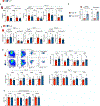Myocardial infarction augments sleep to limit cardiac inflammation and damage
- PMID: 39478215
- PMCID: PMC11998484
- DOI: 10.1038/s41586-024-08100-w
Myocardial infarction augments sleep to limit cardiac inflammation and damage
Abstract
Sleep is integral to cardiovascular health1,2. Yet, the circuits that connect cardiovascular pathology and sleep are incompletely understood. It remains unclear whether cardiac injury influences sleep and whether sleep-mediated neural outputs contribute to heart healing and inflammation. Here we report that in humans and mice, monocytes are actively recruited to the brain after myocardial infarction (MI) to augment sleep, which suppresses sympathetic outflow to the heart, limiting inflammation and promoting healing. After MI, microglia rapidly recruit circulating monocytes to the brain's thalamic lateral posterior nucleus (LPN) via the choroid plexus, where they are reprogrammed to generate tumour necrosis factor (TNF). In the thalamic LPN, monocytic TNF engages Tnfrsf1a-expressing glutamatergic neurons to increase slow wave sleep pressure and abundance. Disrupting sleep after MI worsens cardiac function, decreases heart rate variability and causes spontaneous ventricular tachycardia. After MI, disrupting or curtailing sleep by manipulating glutamatergic TNF signalling in the thalamic LPN increases cardiac sympathetic input which signals through the β2-adrenergic receptor of macrophages to promote a chemotactic signature that increases monocyte influx. Poor sleep in the weeks following acute coronary syndrome increases susceptibility to secondary cardiovascular events and reduces the heart's functional recovery. In parallel, insufficient sleep in humans reprogrammes β2-adrenergic receptor-expressing monocytes towards a chemotactic phenotype, enhancing their migratory capacity. Collectively, our data uncover cardiogenic regulation of sleep after heart injury, which restricts cardiac sympathetic input, limiting inflammation and damage.
© 2024. The Author(s), under exclusive licence to Springer Nature Limited.
Conflict of interest statement
Competing interests
C.S.M. is a consultant for Granite Bio. J.F.d.S. and B.P.K. are inventors on patents or patent applications filed by Mass General Brigham (MGB) that describe genome engineering technologies. B.P.K. is a consultant for EcoR1 capital and Novartis Venture Fund, and is on the scientific advisory board of Acrigen Biosciences, Life Edit Therapeutics and Prime Medicine. B.P.K. has a financial interest in Prime Medicine, a company that is developing therapeutic CRISPR–Cas technologies for gene editing. The interests of B.P.K. were reviewed and are managed by Massachusetts General Hospital (MGH) and MGB in accordance with their conflict-of-interest policies. The other authors declare no competing interests.
Figures













Comment in
-
Monocytes migrate to the brain after MI to promote deep sleep to aid cardiac healing.Nat Rev Cardiol. 2025 Jan;22(1):4. doi: 10.1038/s41569-024-01106-x. Nat Rev Cardiol. 2025. PMID: 39543307 No abstract available.
References
-
- Ziegler KA et al. Immune-mediated denervation of the pineal gland underlies sleep disturbance in cardiac disease. Science 381, 285–290 (2023). - PubMed
-
- Laugsand LE, Vatten LJ, Platou C & Janszky I Insomnia and the risk of acute myocardial infarction: a population study. Circulation 124, 2073–2081 (2011). - PubMed
MeSH terms
Substances
Grants and funding
- R01 HL168897/HL/NHLBI NIH HHS/United States
- R01 AG082185/AG/NIA NIH HHS/United States
- R01 HL158534/HL/NHLBI NIH HHS/United States
- T32 HL160511/HL/NHLBI NIH HHS/United States
- DP2 CA281401/CA/NCI NIH HHS/United States
- R01 HL128226/HL/NHLBI NIH HHS/United States
- T32 AI078892/AI/NIAID NIH HHS/United States
- UL1 TR001873/TR/NCATS NIH HHS/United States
- R35 HL155670/HL/NHLBI NIH HHS/United States
- R00 HL151750/HL/NHLBI NIH HHS/United States
- T32 HL007824/HL/NHLBI NIH HHS/United States
- P01 HL142494/HL/NHLBI NIH HHS/United States
- R01 HL143221/HL/NHLBI NIH HHS/United States
- T32 HL007343/HL/NHLBI NIH HHS/United States
LinkOut - more resources
Full Text Sources
Medical
Molecular Biology Databases
Research Materials

